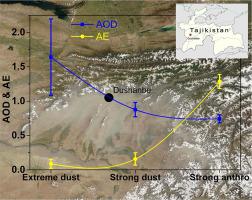Geoscience Frontiers ( IF 8.5 ) Pub Date : 2021-06-18 , DOI: 10.1016/j.gsf.2021.101251 Dipesh Rupakheti , Maheswar Rupakheti , Xiufeng Yin , Julian Hofer , Mukesh Rai , Yuling Hu , Sabur F. Abdullaev , Shichang Kang

|
The location of Central Asia, almost at the center of the global dust belt region, makes it susceptible for dust events. The studies on atmospheric impact of dust over the region are very limited despite the large area occupied by the region and its proximity to the mountain regions (Tianshan, Hindu Kush-Karakoram-Himalayas, and Tibetan Plateau). In this study, we analyse and explain the modification in aerosols’ physical, optical and radiative properties during various levels of aerosol loading observed over Central Asia utilizing the data collected during 2010–2018 at the AERONET station in Dushanbe, Tajikistan. Aerosol episodes were classified as strong anthropogenic, strong dust and extreme dust. The mean aerosol optical depth (AOD) during these three types of events was observed a factor of ~3, 3.5 and 6.6, respectively, higher than the mean AOD for the period 2010–2018. The corresponding mean fine-mode fraction was 0.94, 0.20 and 0.16, respectively, clearly indicating the dominance of fine-mode anthropogenic aerosol during the first type of events, whereas coarse-mode dust aerosol dominated during the other two types of events. This was corroborated by the relationships among various aerosol parameters (AOD vs. AE, and EAE vs. AAE, SSA and RRI). The mean aerosol radiative forcing (ARF) at the top of the atmosphere (ARFTOA), the bottom of the atmosphere (ARFBOA), and in the atmosphere (ARFATM) were −35 ± 7, −73 ± 16, and 38 ± 17 Wm−2 during strong anthropogenic events, −48 ± 12, −85 ± 24, and 37 ± 15 Wm−2 during strong dust event, and −68 ± 19, −117 ± 38, and 49 ± 21 Wm−2 during extreme dust events. Increase in aerosol loading enhanced the aerosol-induced atmospheric heating rate to 0.5–1.6 K day−1 (strong anthropogenic events), 0.4–1.9 K day−1 (strong dust events) and 0.8–2.7 K day−1 (extreme dust events). The source regions of air masses to Dushanbe during the onset of such events are also identified. Our study contributes to the understanding of dust and anthropogenic aerosols, in particular the extreme events and their disproportionally high radiative impacts over Central Asia.
中文翻译:

中亚杜尚别上空强气溶胶事件期间气溶胶物理、光学和辐射特性的变化
中亚的位置几乎处于全球沙尘带区域的中心,使其容易发生沙尘事件。尽管该地区占地面积大且靠近山区(天山、兴都库什-喀喇昆仑-喜马拉雅山脉和青藏高原),但对该地区灰尘对大气影响的研究非常有限。在这项研究中,我们利用 2010-2018 年在塔吉克斯坦杜尚别 AERONET 站收集的数据,分析和解释了在中亚观测到的不同气溶胶负载水平期间气溶胶物理、光学和辐射特性的变化。气溶胶事件被归类为强人为、强沙尘和极端沙尘。观察到这三种事件期间的平均气溶胶光学深度 (AOD) 分别为~3、3.5 和 6.6 倍,高于 2010-2018 年期间的平均 AOD。相应的平均细模式分数分别为 0.94、0.20 和 0.16,清楚地表明细模式人为气溶胶在第一类事件中占主导地位,而粗模式沙尘气溶胶在其他两类事件中占主导地位。各种气溶胶参数(AOD 与 AE,以及 EAE 与 AAE、SSA 和 RRI)之间的关系证实了这一点。大气顶部的平均气溶胶辐射强迫 (ARF) (ARF) 各种气溶胶参数(AOD 与 AE,以及 EAE 与 AAE、SSA 和 RRI)之间的关系证实了这一点。大气顶部的平均气溶胶辐射强迫 (ARF) (ARF) 各种气溶胶参数(AOD 与 AE,以及 EAE 与 AAE、SSA 和 RRI)之间的关系证实了这一点。大气顶部的平均气溶胶辐射强迫 (ARF) (ARF)TOA )、大气底部 (ARF BOA ) 和大气中 (ARF ATM )在强人为事件期间分别为 -35 ± 7、-73 ± 16 和 38 ± 17 Wm -2, -48 ± 12, -在强沙尘事件期间为85±24 和 37±15 Wm -2,在极端沙尘事件期间为-68±19、-117±38 和 49±21 Wm -2。气溶胶负荷的增加将气溶胶引起的大气加热速率提高到 0.5-1.6 K 天-1(强人为事件)、0.4-1.9 K 天-1(强沙尘事件)和 0.8-2.7 K 天-1(极端粉尘事件)。还确定了此类事件发生期间杜尚别气团的源区。我们的研究有助于了解灰尘和人为气溶胶,特别是极端事件及其对中亚的不成比例的高辐射影响。









































 京公网安备 11010802027423号
京公网安备 11010802027423号